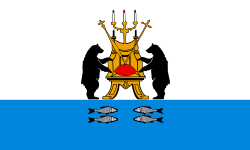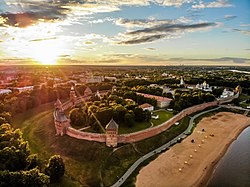Veliky Novgorod
| Wikimedia Commons has media related to Lua error in Module:Commons_link at line 62: attempt to index field 'wikibase' (a nil value).. |
Veliky Novgorod (Russian: Вели́кий Но́вгород) is a city in the European part of Russia. It is the administrative center of Novgorod Oblast. It is about 200 kilometres (120 miles) from St. Petersburg. In 2007, about 217,000 people lived there. "Novgorod" is the Russian word for "new city" and "Veliky" means "the Great". The city is actually one of the most historic in Russia. Its past can be traced to the 9th century. Yaroslav the Wise ruled there in the 11th century. It was the only Russian province that was not captured by the Golden Horde.
Veliky Novgorod Media
Cathedral of Saint Sophia, a symbol of the city and the main cathedral of the Novgorod Republic
Monastery of the Tithes is one of eight ancient monasteries of the old Russian state Novgorodian Rus'
12th-century Novgorod icon called The Angel with Golden Hair
The Millennium of Russia monument (1862), with Saint Sophia Cathedral in the background. The upper row of figures is cast in the round and the lower one is in relief.
St. Nicholas Cathedral, built by Mstislav I near his palace at Yaroslav's Court, Novgorod, contains 12th-century frescoes depicting his illustrious family












